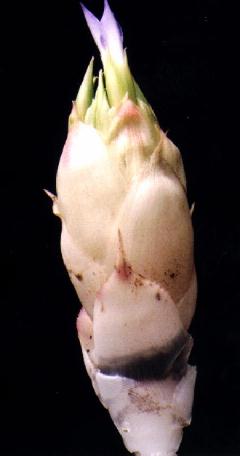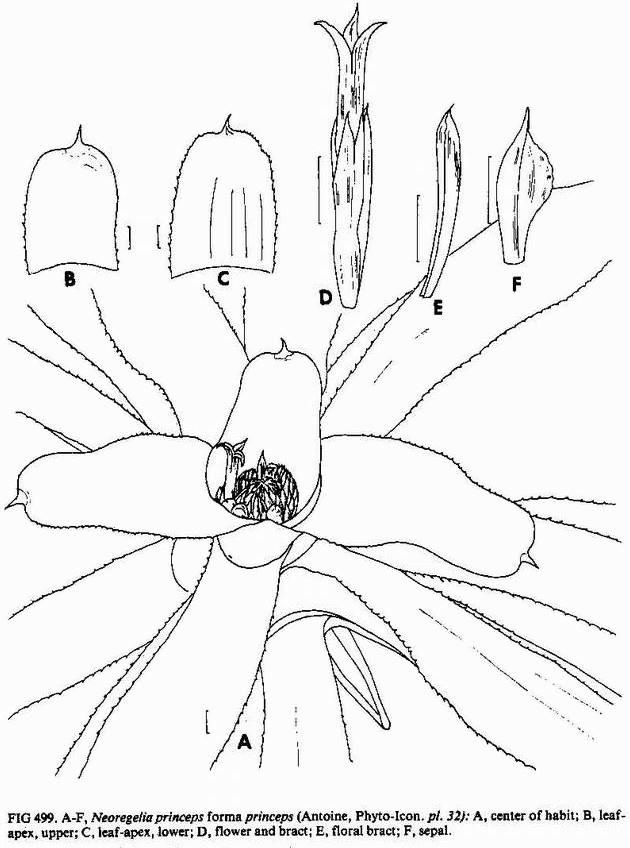I have found this species the most elusive to find in cultivation, certainly in Australia and no doubt in the USA. All plants labelled N. princeps fall well short of the description and the closest ones I have found had the name N. pineliana to add to the confusion.
In 1946 the correctly named plant must have been in Europe because Dutrie describes it as a :- “Squat plant which has a dense rosette with leaves 4-5cm wide, bluish-green above, densely lepidote beneath, rounded and mucronate, slightly toothed. The bracteate leaves (now called inner leaves) are bright rose-red. A character which I have not noticed in any other description: the sepals and the small floral bracts are reddish-orange, while in other species they are dull green. Since they have the appearance of petals, the inflorescence looks like a round, reddish-orange skull cap set in the bottom of the rosette formed by the leaves, thus adding to the plant’s charm. It should be noted that this characteristic is transmitted to its hybrids.”
This description ties in very closely to the description in Smith & Downs page 1547 with the added bonus of knowing that the outer floral bracts act as a sort of hood. As Dutrie says, this trait occurs in its hybrids as is evidenced to this day and is one of my quick checks to see if I am on the right trail for a true N. princeps.
There is another form of N. princeps which goes by the unusual name of phyllanthidea. Lyman Smith separates them by:-
1. forma princeps - Outer bracts of inflorescence smaller than the inner leaves.
2. forma phyllanthidea - Outer bracts of the inflorescence enlarged and foliaceous but bright red. (By inference this means that the outer bracts equal or exceed in length the inner leaves!)
I had always puzzled what this aberration of a plant could look like with a description used nowhere else in the genus Neoregelia. Could it be a hybrid with Nidularium?
Recently I was able to obtain a copy of those BSI Journals out of stock (and very elusive!) for 1973. On page 133 is a photograph of Neoregelia princeps f. phyllanthidea by Raulino Reitz which is reproduced here and doesn’t seem to fully link with Lyman Smith’s description. There is a clue that this plant is only known from cultivation and at least something similar was alive in Brazil in 1973. Is this plant still alive? Could it be examined again to satisfy my curiosity now we know more about bigeneric hybrids?
So the plea is out to Brazilian growers. Is the true N. princeps still growing in the wild? If so, what are the chances of wild collected seed being made available. An authentic photo would be great too!


Neoregelia princeps forma princeps.
Karatas meyendorffii Antoine, Phyto-Icon. 54, pI. 32. 1884; in part, not as to basonym.
Nidularium marichalii hort. Makoy ex Baker, Handb. Bromel. 9. 1889; nomen (! Mez).
Karatas princeps Baker, Handb. Bromel. 10. 1889.
Nidularium princeps E. Morren ex Baker, Handb. Bromel. 10. 1889; nomen.
Nidularium spectabile hort. ex Baker, Handb. Bromel. 10. 1889; nomen, non Moore 1873.
Regelia princeps (Baker as "E. Morren") Lindman, Oefvers. Vet. Akad. Forhandl. 47: 543. 1890.
Regelia marechalii Lindman, Oefvers. Vet. Akad. Forhandl. 47: 543. 1890; nomen, because intended combination based on a nomen.
Aregelia princeps (Baker) Mez, DC. Monogr. Phan. 9: 75. 1896.
Nidularium meyendorfii var pruinosum E. Morren ex Mez, DC. Monogr. Phan. 9: 76. 1896; nomen based on Morren Icon.
Aregelia marechalii Mez, Pflanzenreich IV. Fam. 32: 43. 1934, as to the intended new combination and invalid name based on the Morren Icon, but not as to description and other material cited.
Outer bracts of the inflorescence smaller than the inner leaves.
Type. Hortus E. Morren s n (holotype K, Morren Icon), South Brazil.
Distribution. Rio de Janeiro (on the basis of Glaziou 16446 and Ule 4961 e.p.) and Santa Catarina (on the basis of d'Urville s n) according to Mez but the material evidently lost.
Neoregelia princeps (Baker) L. B. Smith forma phyllanthidea (Mez) L. B. Smith, Phytologia 15: 185. 1967.
Aregelia princeps (Baker) Mez var phyllanthidea Mez, DC. Mon. Phan. 9: 76. 1896. Type: Description.
Neoregelia princeps (Baker) L. B. Smith var phyllanthidea (Mez) L. B. Smith, Smithsonian Misc. Coll. 126:31.1955.
Outer bracts of the inflorescence enlarged and foliaceous but bright red.
Described from cultivation, no surviving material known.